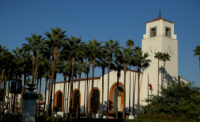B+U
Downey Office Building, 2009
A history of what didn’t happen can sometimes be even more revealing and thought provoking than what did. That curious inversion of circumstance fuels Never Built: Los Angeles, a show at the A+D Architecture and Design Museum focused on more than a century of ambitious designs, some right on the brink of realization—that never broke ground in the city.
Alongside visionaries who have vanished into obscurity, the thwarted include such famous names as Neutra, Lautner, Morphosis, Gehry, and Nouvel. "Despite the incredible concentration of architectural talent and energy here," says Sam Lubell, west coast editor of The Architect’s Newspaper (and a former Architectural Record editor), who co-curated the exhibition with Greg Goldin, "L.A. has often settled for second best in the public realm."
For three years, Lubell and Goldin sifted through local archives—held by municipal agencies, universities, museums, design firms, libraries, and historical societies—to unearth long-forgotten schemes, as well as proposals shelved as recently as last year. They dug up grand visions for transit networks, urban plans, parks, skyscrapers, and more, portrayed in models, drawings, and renderings that are often works of art themselves. The memorable images include Lloyd Wright’s chasm-like civic center with subterranean streets (1925); S. Charles Lee’s dramatic 1940s theater facades; Frank Lloyd Wright’s cascading Huntington Hartford Sports club (1947); and Robert Stacy-Judd’s 1931 watercolor for his exotic National Hall complex. Strikingly, the show’s diverse presentation styles, from heroic to futuristic, seem to reflect the tenor and aspirations of the times as much as the design ideas they depict.
Most of the schemes fell prey to economic and political vagaries. But for all the amazing, transforming proposals that make us wish for "what might have been," Los Angeles can be thankful for dodging some serious bullets. Among the greatest missed opportunities was landscape architect Aurele Vermeulen’s Archway Plan (1922) for a tree-lined boulevard, punctuated by poetic and monumental archways and fountains, that would have traversed the metropolis in a uniquely Angeleñan manner, reminiscent of Paris and Rome. Another huge loss was Olmsted Brothers and Bartholemew’s 1930 master plan for protecting beachfront and lacing parks through the city—presciently recognizing, 83 years ago, the region’s risk of becoming park starved.
But, luckily, the 1960s Santa Monica Causeway scheme was quashed, blocking a deadly urban manipulation: a coastline-butchering string of manmade islands, carrying an offshore freeway and high-rise development. And if the city’s master planners had their way in 1958, an unrelenting grid of 1,600 freeway miles (vastly multiplying the current offerings) would have sliced up Los Angeles, aggressively leveling canyon passes.
Certainly, some of the imagination-sparking ideas here would have brought a mix of pros and cons. Perreira and Luckman’s giant, glass-lidded, unified terminal (1952) for Los Angeles International Airport, complete with hydraulically levitated lounges, would have created a memorable, Jetson-like gateway to La-La Land (something now lacking)—but cooling that colossal central space, or convincing the airlines to share a single building, would have been far more difficult. The airport's only relic of that radical style and thinking is its 1961 space ship-like Theme Building, housing a restaurant.
Over the decades, certain unresolved challenges have been revisited repeatedly, including ideas for a suspended monorail or aerial tramway network, and a museum for the motion picture industry (it may come to fruition this time in a Renzo Piano-Zoltan Pali scheme that incorporates the 1939 former May Company department store building). And though buildable proposals form the crux of the show, it includes a few follies, such as Culver City’s 1966 palm-fringed Sky (or ski) Slope.
As Never Built exuberantly illuminates in an installation designed by Clive Wilkinson Architect, the evolution of an urban area lies not only in what gets built—or demolished—but also in what fails to rise there. Yet the contention that this sprawling metropolis and its diffuse government squelched an inordinate number of innovative or worthy projects, as the exhibition catalog suggests, remains debatable. Show me a major city, and I’ll show you a morgue full of never-builts. That said, many of these schemes have enduring relevance and merit a closer look in the context of Los Angeles’s ongoing narrative.



















Post a comment to this article
Report Abusive Comment